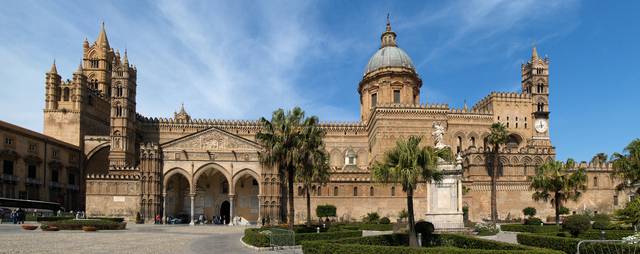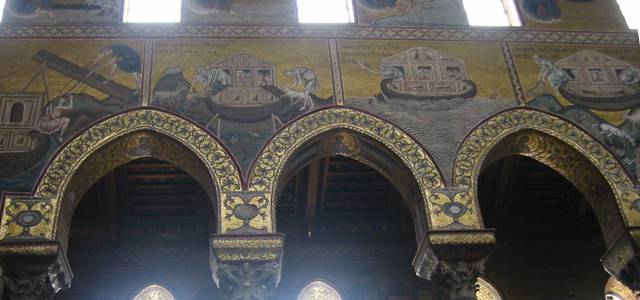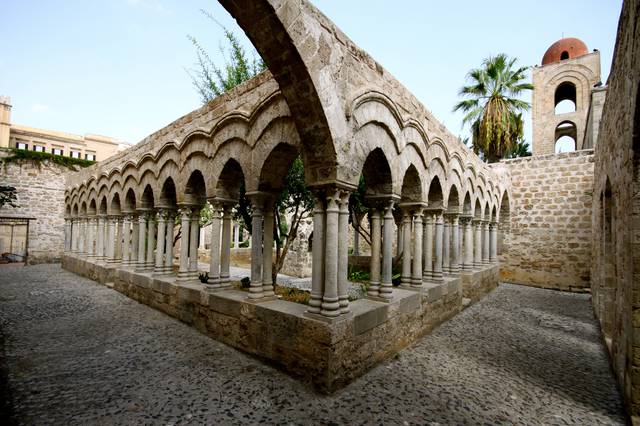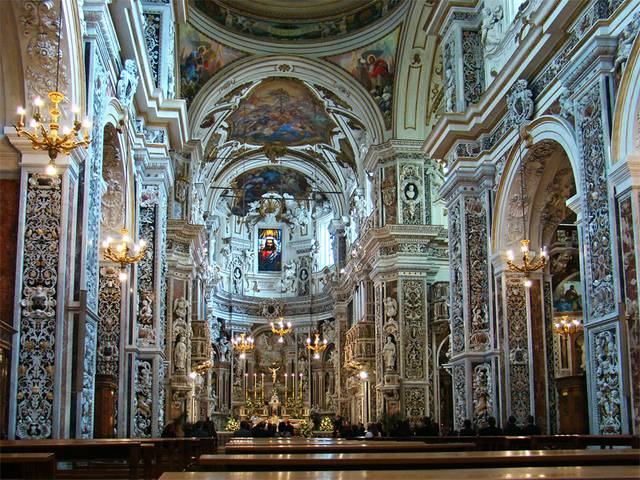Palermo (Sicilian: Palermu) is on the northern coast of the Italian island of Sicily. It's the capital city of the autonomous region of Sicily and of its own province.

The city's economy is based on local government institutions, port, shipbuilding industry and the mechanical industry. It is also seat to some important Sicilian wine-making companies (like Tasca d'Almerita, Duca di Salaparuta, Corvo, and Planeta) whose popularity in the world is growing.
Capital of Sicily, founded by Phoenicians under the name of Ziz (= Flower, but the meaning is still doubtful), later renamed by Greeks Panormos, which means "all port". It reached its golden age during the Arab domination (from 9th to 11th centuries AD) when it became one of the most prosperous cities in the Mediterranean and Europe, known as "city of delights" for its marvelous and lavish gardens, as well as for magnificent mosques and palaces.
After being conquered by the Normans (1060-1080 AD), most of palaces and mosques were destroyed, but the new rulers exploited the cosmopolitan environment of Palermo and the artists, architects and masters from different cultural roots giving the birth to a unique architectural style, the so-called "Arab-Norman Style of Sicily", which is an original mixture of arabesque decorations, Romanesque architecture and Byzantine mosaics. After being home to one of the most famous Emperors of the Middle Ages, Frederick II of Swabia, named "Stupor Mundi" by contemporaries, Palermo began its decadence under the influence of several dominations (French, Aragonese, Spanish and Bourbons from Naples.
In the middle of 19th century, during the so-called "Italian Risorgimento" Palermo was one the leading revolutionary cities in Italy, strongly contributing to the success of the Thousand patriots' expedition lead by the famous Italian national hero Giuseppe Garibaldi, which ended with the reunification of Italy under the Savoy dynasty from Turin (1860).
Nowadays Palermo faces several problems affecting its economic development, mainly because of the presence of the very powerful criminal organization known worldwide as "Mafia" or "Cosa Nostra".
 Because of its variety of monuments, attesting to its long and rich history, and the number of other cultural and naturalistic attractions, Palermo can offer a very interesting experience to the visitor interested in exploring it. The Cathedral of Monreale, the Royal Palace and Palatine Chapel, the Church of San Giovanni degli Eremiti, the Church of Santa Maria dell’Ammiraglio, the Church of San Catalado, the Palermo Cathedral, the Zisa Palace and the Admiral’s Bridge, comprise together with the cathedral in Cefalù the world heritage site “Arab-Norman Palermo and the Cathedral Churches of Cefalù and Monreale”.
Because of its variety of monuments, attesting to its long and rich history, and the number of other cultural and naturalistic attractions, Palermo can offer a very interesting experience to the visitor interested in exploring it. The Cathedral of Monreale, the Royal Palace and Palatine Chapel, the Church of San Giovanni degli Eremiti, the Church of Santa Maria dell’Ammiraglio, the Church of San Catalado, the Palermo Cathedral, the Zisa Palace and the Admiral’s Bridge, comprise together with the cathedral in Cefalù the world heritage site “Arab-Norman Palermo and the Cathedral Churches of Cefalù and Monreale”.
- Palermo Cathedral, Corso Vittorio Emanuele, +39 091 334373. Honey-colored and Catalan influenced. Frederick II, Barbarossa's son, died in 1250 and is buried here, far from his ancestral home above Hohenstaufen, Germany. Frederick's sarcophagus is of porphyry dyed with imperial purple.
-oLNFG.medium.jpg)
- Palatine Chapel, Piazza Indipendenza, +39 091 705 4317. M-F 09:00-11:45, 15:00-16:45; Sa 09:00-11:45; Su 09:00-09:45, 12:00-12:45. It's one of the artistic gems of Palermo: a chapel with magnificent mosaics and Arabian-style decorations, among the most beautiful in the world. It is located inside of Palazzo dei Normanni. Free.
- Palazzo dei Normanni, Piazza del Parlamento, 1. The oldest royal residence in Europe, the home of the rulers of the Kingdom of Sicily and imperial seat of the Emperor Frederick II. The palace contains the Cappella Palatina, the best example of the Arab-Norman style of Sicily. Nowadays it is the seat of the Sicilian Parliament.

- San Giovanni degli Eremiti, Via dei Bernadetti, +39 091 651 5019. M-Sa 09:00-19:00. Church notable for its brilliant red domes, which show the persistence of the Arab influences in the 12th century, with its typical Arab-Norman style. The €6 admission ensures that the lovely garden is quiet and peaceful.
- Museo Archeologico.
- Catacombe dei Cappuccini, Piazza Cappuccini (just west of the city centre. 09:00-12:00 and 15:00-18:00. The catacombs of the Capuchin convent contain over 8,000 mummified ex-residents from Palermo and its surrounding villages, some merely clothed skeletons, other remarkably well-preserved and lifelike. Well worth a visit, interesting, if slightly morbid. Children may either find it exciting or terrifying, and it must be the responsibility of their parents to think carefully before taking them. You can arrive via the new tram line that opened in 2015 and a 10- to 15-minute walk. Your visit will not take longer than one hour. €3.

- The Gesu Church is one of the most architecturally important in Palermo. Constructed between 1564–1633, it's late date of completion resulted in an abundant use of polychrome marbles on both floors and walls. This form of decoration, which gradually evolved in Sicily from the beginning of the 17th century, was a mark of the beginning of the Sicilian Baroque period, which was to give Sicily almost an architectural national identity. Note that the church has a modest facade and it's hidden in back street in central Palermo, unlike the great cathedral this one you have to look for.
- Quattro Canti - the symbolic crossroads at the old centre of the city and the nearby small, but pretty La Martorana church with Byzantine mosaics inside.
- Piazza Garraffello near Vucciria on Friday nights a DJ is playing open air if the weather is good. Huge crowd dancing. There are also lots of bars right next to the square.
- Piazza Pretoria, including the Fontana Pretoria
- The Zisa and the Cuba, Arabic-Norman royal palaces. The Zisa is in Piazza Zisa; the Cuba in Corso Calatafimi.
- Monreale - a village/suburb 8 km west of Palermo, sitting on the hill with a great view back towards the city and the sea. Be sure to visit the Duomo (Cathedral) and its cloisters too.
Palermo Cathedral, Corso Vittorio Emanuele, +39 091 334373. Honey-colored and Catalan influenced. Frederick II, Barbarossa's son, died in 1250 and is buried here, far from his ancestral home above Hohenstaufen, Germany. Frederick's sarcophagus is of porphyry dyed with imperial purple.
Palatine Chapel, Piazza Indipendenza, +39 091 705 4317. M-F 09:00-11:45, 15:00-16:45; Sa 09:00-11:45; Su 09:00-09:45, 12:00-12:45. It's one of the artistic gems of Palermo: a chapel with magnificent mosaics and Arabian-style decorations, among the most beautiful in the world. It is located inside of Palazzo dei Normanni. Free.
Palazzo dei Normanni, Piazza del Parlamento, 1. The oldest royal residence in Europe, the home of the rulers of the Kingdom of Sicily and imperial seat of the Emperor Frederick II. The palace contains the Cappella Palatina, the best example of the Arab-Norman style of Sicily. Nowadays it is the seat of the Sicilian Parliament.
San Giovanni degli Eremiti, Via dei Bernadetti, +39 091 651 5019. M-Sa 09:00-19:00. Church notable for its brilliant red domes, which show the persistence of the Arab influences in the 12th century, with its typical Arab-Norman style. The €6 admission ensures that the lovely garden is quiet and peaceful.
Museo Archeologico.
Catacombe dei Cappuccini, Piazza Cappuccini (just west of the city centre. 09:00-12:00 and 15:00-18:00. The catacombs of the Capuchin convent contain over 8,000 mummified ex-residents from Palermo and its surrounding villages, some merely clothed skeletons, other remarkably well-preserved and lifelike. Well worth a visit, interesting, if slightly morbid. Children may either find it exciting or terrifying, and it must be the responsibility of their parents to think carefully before taking them. You can arrive via the new tram line that opened in 2015 and a 10- to 15-minute walk. Your visit will not take longer than one hour. €3.
The Gesu Church is one of the most architecturally important in Palermo. Constructed between 1564–1633, it's late date of completion resulted in an abundant use of polychrome marbles on both floors and walls. This form of decoration, which gradually evolved in Sicily from the beginning of the 17th century, was a mark of the beginning of the Sicilian Baroque period, which was to give Sicily almost an architectural national identity. Note that the church has a modest facade and it's hidden in back street in central Palermo, unlike the great cathedral this one you have to look for.
Quattro Canti - the symbolic crossroads at the old centre of the city and the nearby small, but pretty La Martorana church with Byzantine mosaics inside.
Piazza Garraffello near Vucciria on Friday nights a DJ is playing open air if the weather is good. Huge crowd dancing. There are also lots of bars right next to the square.
Piazza Pretoria, including the Fontana Pretoria
The Zisa and the Cuba, Arabic-Norman royal palaces. The Zisa is in Piazza Zisa; the Cuba in Corso Calatafimi.
Monreale - a village/suburb 8 km west of Palermo, sitting on the hill with a great view back towards the city and the sea. Be sure to visit the Duomo (Cathedral) and its cloisters too.
The "Pizzo free" shops are a group of shopkeepers that refuse to pay the racket to the Mafia. The Palermitan consumers sustain them by going shopping in their stores. These shops are easily recognisable by a sticker in the shop/restaurant window.
- Isola Saporita, +39 091 6527506. Corso Vittorio Emanuele 504 (opposite the cathedral). Good selection of wine, oil, marmalade, sauces, etc.
- Mercato di Ballarò, Via Ballarò, Piazze de Carmine. M Tu Th-Sa 07:00-20:00, W 07:00-13:00. Busy food market in Albergheria.
- La Coppola Storta, Via Bara all'Olivella 74, +39 091324428. This cap, originally of Sicilian peasants and later of the Mafia, has become a stylish accessory.
Isola Saporita, +39 091 6527506. Corso Vittorio Emanuele 504 (opposite the cathedral). Good selection of wine, oil, marmalade, sauces, etc.
Mercato di Ballarò, Via Ballarò, Piazze de Carmine. M Tu Th-Sa 07:00-20:00, W 07:00-13:00. Busy food market in Albergheria.
La Coppola Storta, Via Bara all'Olivella 74, +39 091324428. This cap, originally of Sicilian peasants and later of the Mafia, has become a stylish accessory.
Try specialties of Palermo like panino con la milza or panelle, in one of the many sandwich stands in the old city center.
- Antica Focacceria S. Francesco, Via A Paternostro, 58 (In the small piazza in front front of S. Francesco church. 11:00-15:30, 17:30-23:30. - a tourist trap - Main courses €15, fast food €5.
- Il Proverbio, +39 091 6173267. Via Discesa 24. Close to station and Quattro Canti. Great Sicilian food, most dishes are €4-6.
- Al Chioschetto. Pz. Indipendenza Di Fronte N. 31. Close to the new gate. Excellent fresh panini and salads. They keep all the ingredients in a cooled glass counter, makes the panini from scratch when you order, using only freshly cut pieces of meat.
- Le pergamene, Piazza Marina 48 (near of the Palazzo Chiaramonte Steri, +39 091 6166142.
- Pizza Gaetano, Via XII Gennaio, 1/Q, +39 091 6014544. Authentic pizza and pasta dishes. Not touristy at all.
- Pipi Room, V. XX Settembre 59. Antipasto, pizzas, etc.
- Antico Caffé Spinnato, Via Principe di Belmonte 107/115, +39 091329220.
- Osteria dei Vespri, Piazza Croce dei Vespri 6, +39 091617631. M-Sa 12:00-15:00, 18:00-24:00.
- Paticceria Capello, Via Nicolo Garzili 10, +39 0916113769. Th-Tu 07:00-22:00, W closed.
- Pasticceria Capello, Via Colonna Rotta 58, +39 091489601. Th-Tu 07:00-22:00, W closed.
- Trattoria al Piccolo Napoli, Piazzetta Mulino a Vento 4, +39 091320431.
Antica Focacceria S. Francesco, Via A Paternostro, 58 (In the small piazza in front front of S. Francesco church. 11:00-15:30, 17:30-23:30. - a tourist trap - Main courses €15, fast food €5.
Il Proverbio, +39 091 6173267. Via Discesa 24. Close to station and Quattro Canti. Great Sicilian food, most dishes are €4-6.
Al Chioschetto. Pz. Indipendenza Di Fronte N. 31. Close to the new gate. Excellent fresh panini and salads. They keep all the ingredients in a cooled glass counter, makes the panini from scratch when you order, using only freshly cut pieces of meat.
Le pergamene, Piazza Marina 48 (near of the Palazzo Chiaramonte Steri, +39 091 6166142.
Pizza Gaetano, Via XII Gennaio, 1/Q, +39 091 6014544. Authentic pizza and pasta dishes. Not touristy at all.
Pipi Room, V. XX Settembre 59. Antipasto, pizzas, etc.
Antico Caffé Spinnato, Via Principe di Belmonte 107/115, +39 091329220.
Osteria dei Vespri, Piazza Croce dei Vespri 6, +39 091617631. M-Sa 12:00-15:00, 18:00-24:00.
Paticceria Capello, Via Nicolo Garzili 10, +39 0916113769. Th-Tu 07:00-22:00, W closed.
Pasticceria Capello, Via Colonna Rotta 58, +39 091489601. Th-Tu 07:00-22:00, W closed.
Trattoria al Piccolo Napoli, Piazzetta Mulino a Vento 4, +39 091320431.
- Enoteca Picone, Via Marconi 36, +39 091331300.
Enoteca Picone, Via Marconi 36, +39 091331300.
Beware of pickpockets on the streets and city buses as well as motorcycle-riding snatch thieves targeting handbags, wallets and mobile phones.
Keeping the above in mind, travellers can safely visit the old centre of Palermo, also at night, including via Maqueda and its surrounding area, or La Kalsa, between Via Roma and the water, where hundreds of bars and pubs are open all night, especially during the weekend. The area is being renewed and gentrified; even if it's generally safe, it is better to be wary at night.
Vehicle theft is a major problem in Italy, but, as evinced by latest figures made available by Italian Police, Palermo is safer than Rome, Naples, Milan, Bari, Catania and Turin, but if you want avoid any risk so the use of private, secure car parks is to be preferred.
- Internet Shop. Via Napoli N, 32. Tel: +39 091 584146. 13 computers, E2.5/hour. Wireless internet.
- Mediapoint Via Maqueda 221, tel:+39 091 6113332. close to 4CANTI, 4c/min. Picture backup in CD or DVD, memory cards available.
- Aboriginal Internet Cafe, Via S. Spinuzza 51, close to Teatro Massimo, Tel: +39 091 6622229, . Also serves beer and drinks with obscene names.
Internet Shop. Via Napoli N, 32. Tel: +39 091 584146. 13 computers, E2.5/hour. Wireless internet.
Mediapoint Via Maqueda 221, tel:+39 091 6113332. close to 4CANTI, 4c/min. Picture backup in CD or DVD, memory cards available.
Aboriginal Internet Cafe, Via S. Spinuzza 51, close to Teatro Massimo, Tel: +39 091 6622229, . Also serves beer and drinks with obscene names.
Palermo's main APT Tourist Office is located at Piazza Castelnuovo 35, open M-F 08:00-20:00 and Sa 08:00-14:00. English spoken. A branch of the tourist office also exists at the airport. Get a free map from one of the blue information booths.
- Bagheria. A small town east of Palermo. There are a handful a beautiful villas there and a museum of renowned painter Renato Guttuso.
* Villa Palagonia, Piazza Garibaldi, 3-90011 Bagheria (PA), +39 091 932 088. Nov-Mar: 09:00-13:00, 15:30-17:30; Apr-Oct: 09:00-13:00, 16:00-19.00. A splendid richly decorated 18th century villa. Perhaps it's most known for numerous grotesque statues that adorn the garden and its wall. Through them the villa earned its nickname Villa dei Mostri (the Villa of Monsters).
Bagheria. A small town east of Palermo. There are a handful a beautiful villas there and a museum of renowned painter Renato Guttuso.
* Villa Palagonia, Piazza Garibaldi, 3-90011 Bagheria (PA), +39 091 932 088. Nov-Mar: 09:00-13:00, 15:30-17:30; Apr-Oct: 09:00-13:00, 16:00-19.00. A splendid richly decorated 18th century villa. Perhaps it's most known for numerous grotesque statues that adorn the garden and its wall. Through them the villa earned its nickname Villa dei Mostri (the Villa of Monsters).
Cefalù, Milazzo (for the Aeolian Islands), Messina, Trapani and Enna could be reached by regular and relatively trains.
While for Catania, Taormina, Agrigento, and Syracuse perhaps it's better to take bus.
